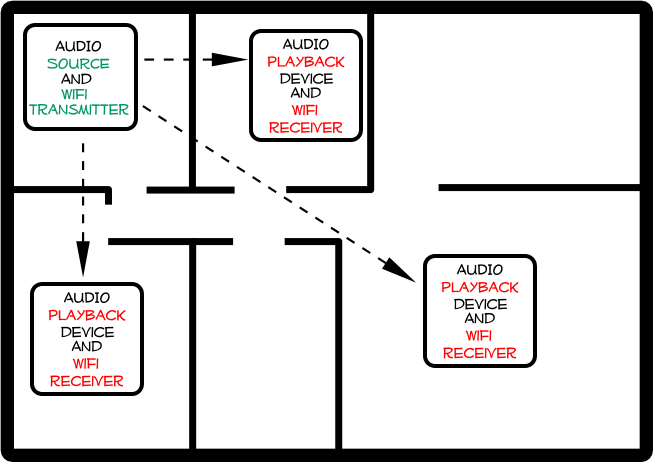How do you connect that MP3 player, radio or other device to your motorcycle intercom system?
A Bluetooth adapter/transmitter is the way to go.
An indispensible device for today's connected motorcyclist but, for some reason, still not widely known, understood or utilized.
All three of these handy-dandy little gems do what they should (and for the most part as advertised) while providing outstanding battery life and the ability to be used while charging.
The Azeca and Bluesense Bluetooth adapters are identical in form, fit and function, less finish, colour and markings, while the TAOtronics Bluetooth adapter has a unique elongated rectangular shape and markings.
All three utilize Bluetooth v2.1 with Class 2 power with support for the A2DP profile for stereo audio streaming to compatible headsets.
All three paired successfully with every Bluetooth receiver device put in front of them, with the TAOtronics device being the speediest; it usually paired up within five to ten seconds whereas the other two took 30 to 40 seconds on average.
Value is what most Bluetooth Adapters provide with a continuing return on investment if the use of non-Bluetooth media devices is the norm.
Mount them with or close to the device, keep them charged up, reset them now and then to clean out the pairing memory and enjoy the audio streaming, what could be simpler than this?
So despite all three being equally functional and worth the investment, I prefer the performance of the TAOtronics TT-BA01. It pairs faster, audio output is better, battery life is slightly better than the other two and its kit includes an AC/DC adapter as a charging option.

Introduction
The Bluetooth Dongle or Adapter or transmitter, commonly referred to as a "BTA", has (thankfully) been around since (almost) the earliest days of consumer Bluetooth availability. And trust me, their day isn’t over yet; for many of us, they remain an indispensable accessory.
A Bluetooth adapter or transmitter has clear advantages: the cost is minimal, but the value is great; that being the ability to take a legacy or non-Bluetooth equipped device and move it into the wireless audio streaming realm.
Got an older audio media or multimedia device? Connect it to a Bluetooth adapter -- typically through a 3.5 mm stereo output jack -- then pair it with a compatible intercom headset or Bluetooth speaker set and just like that, you'll have a wireless connection for streaming stereo audio.
There is still one shortfall though -- portable Bluetooth adapters cannot implement the Audio/Video Remote Control Profile or AVRCP services to a connected non-Bluetooth media player. AVRCP provides the forward/back and next track functionality for your audio device. So even though both the Bluetooth headset and the Bluetooth adapter may be AVRCP compatible, the wireless commands cannot be passed to or interpreted by the media device.
AVRCP is (typically) implemented with the Headset or Hands-free Profiles (HSP/HFP) as they conveniently provide necessary command and control instructions needed to execute the AVRCP features. Many Bluetooth adapters do not support anything other than A2DP.
So in this situation, the limitation is physical rather than wireless and that wired 3.5 mm connection from the media device to the Bluetooth adapter is "dumb", providing one-way audio output from the device to the BTA, but that is it.
This is also the reason why media devices connected directly to a Bluetooth personal or helmet headset system cannot be controlled by AVRCP instructions from the user via the headset.

There is no shortage of portable Bluetooth-enabling devices on the market. This review is focused on the Bluetooth adapter, also known as a Bluetooth transmiiter.
The three Bluetooth adapters presented below are available in unlimited variety at widely varying pricing from a seemingly unlimited number of vendors. All three of these devices fall into the generic mold for Bluetooth Adapters: small, extremely portable and utterly simple to use.
Two of them, the Azeca and GOgroove Bluesense TRM are identical, differentiated only by finish, colour and branding. webBikeWorld has published a fair number of Bluetooth adapter reviews in the past, individually or in conjunction with motorcycle intercom and communications system evaluations. These Bluetooth adapters are very simple devices with very similar functions, I’ve covered form, fit and function briefly in the following sections with a feature and performance comparison at the end.

Azeca is headquartered in Suwanee, Georgia U.S.A. and offer medical devices, phones, computers and TVs with a heavy emphasis on Bluetooth-based products as reflected on their main website.
This adapter kit comes packed with the rectangular 45 x 33 x 8 mm (1.77 x 1.29 x 0.3 in.) Bluetooth adapter, a USB-to-mini coaxial charging cable measuring 123 cm (48.42 in.) long, a plastic bag with two small Velcro squares for mounting the adapter, a short but well-written Owner’s Manual and Warranty Registration Card. No AC/DC charger is provided.
The Azeca adapter has a 9 cm (3.5 in.) stereo lead terminating in a 3.5 mm stereo plug for connecting a non-Bluetooth device and a small LED provides status information. A small main function button (MFB) and co-axial jack port occupy the bottom edge.
Bluetooth v2.1 powered, the Azeca adapter supports the A2DP or Advanced Audio Distribution Profile for wireless stereo audio streaming. It features Class II power for a nominal 10 meter (33 ft.) range. The device is claimed to have a ten hour play time and it can be used while being charged using the supplied charging cable.
[UPDATE (April 2013) - Azeca sent us an email to let everyone know that they now have a Bluetooth transceiver that can both send and receive. It is called the Bluetooth Stereo Streamer (info) that transmits and receives stereo (A2DP).]
Initial charging of the Azeca, using one of the many AC/DC USB-port chargers I have on hand took 2.5 hours. The LED indicator glows red during charging and shuts off once the device is fully charged; a low power state indicated by the indicator flashing red twice every 30 seconds.
The normal convention for use applies; with the Azeca BTA turned off, put the Bluetooth receiver (headset) into the appropriate pairing mode, then hold the MFB on the Azeca for six to nine seconds initiating its pairing mode that is indicated by an initial single blue LED flash, then the usual red/blue flashing pattern. If needed, and if the Bluetooth receiver device provides an input capability, the accepted PIN codes of 0000, 1111, 1234 or 8888 can be used.
Once paired, the LED on the Azeca will flash twice every four seconds followed by the appropriate paired LED sequence and/or voice announcement from the headset. With the BTA and Bluetooth receiving device paired, plug the 3.5 mm connector into your MP3 or other audio device and start a track; stereo audio begins streaming to the headset through the BTA almost immediately.
Note: The Azeca Bluetooth adapter does not support Audio/Video Remote Control Profile or AVRCP; those features will not be available via the headset. Holding the MFB for two to three seconds initiates shutdown, with the red LED flashing once before the device turns off.

BUY YOUR
▪ Motorcycle Intercoms
▪ Motorcycle Intercoms
The Bluesense TRM is marketed under the GOgroove label (speakers, docks, headphones, earbuds, FM Transmitters, etc.). The kit is very basic; the Bluetooth module, a USB charging cord identical to the one provided with the Azeca kit and a small pocket-sized User Guide containing far less information than the more complete Azeca Owner's Manual. No AC/DC adapter is provided.
This Bluetooth Adapter is a clone of the Azeca module in both its form and specifications. The only visual differences are a smoother satin sheen (teal) finish on the Bluesense; the charging port, which is marked as "5V DC" vs. "Input" and it has different brand markings, of course.
Setup, function and performance are all essentially identical to that of the Azeca, although the User Guide provides a few differing recommendations regarding device pairing, etc. As with the Azeca Bluetooth adapter, the Bluesense TRM goes into pairing mode automatically if it hasn’t been previously paired with anything else or doesn’t detect a previously paired device.

Taotronics is another international multi-brand electronics distributor with an address in San Jose, California. Their product listing includes auto electronics, cellphones including Bluetooth devices, computers, home entertainment, home and office products, portable audio and sporting goods.
Inside the environmentally-friendly green cardboard box was the rectangular 60 x 25 x 9 mm (2.3 x 0.9 x 0.35 in.) Bluetooth adapter module (slightly smaller than a disposable cigarette lighter), an AC/DC USB-based adapter, a 120 cm (47.2 in.) long) USB charging cable and a simple instruction manual.
A smooth but tactile black matte finish adds some discrete class. The surface has a shiny (chrome-like) power button and coloured logo, with the left end sporting the 10 cm (3.9 in.) long 3.5 mm connection lead and a micro-USB charging port.
It features Bluetooth v2.1 (not v2.0 as identified on the box) implementation and nominal range of 10 meters (Class 2 power) and A2DP support matches it up with the other two adapters discussed above.
But what is supposed to set this BTA apart doesn't, as expected. The product is clearly identified as supporting both A2DP and AVRCP, but while the adapter may actually be capable of "supporting" AVRCP instructions received from the headset, it cannot execute the necessary control over the connected media device, for the reasons discussed earlier in my Introduction section.
This claim is one seen on many other Bluetooth adapters, including other branded variants of this device, and while it is likely made based on design or marketing objectives, it can be very misleading to consumers.
Something that does work really well with the TT-BA01 is audio output; I don’t know if it has a booster circuit of sorts, but with the media device and headset at the same settings as for the other two adapters there is a clear (positive) difference in output compared to the other two Bluetooth adapters in this review.

The Azeca and Bluesense devices came from the same clone mold so there isn’t much to distinguish them...less the odd variance in LED sequences for power On/Off and Pairing. Without sounding repetitious, all three have virtually identical features and performance, although the TAOtronics Bluetooth adapter claims support for AVRCP whereas the other two do not. It also has the best audio output of all three.
Battery life of these devices is very good; eight to ten hours is clearly achievable from a full charge, with the option to use all three devices while they are also connected via their USB cables for charging, making the power issue moot at times. Again, the TAOtronics battery seems to be the best, although its listed run time is less than the other two…
.
Recognizing that several Bluetooth motorcycle helmet intercom systems now feature a 2.5 or 3.5 mm input port which allows a wired connection can be made to a device, the Bluetooth adapter option is still valid -- and wireless.
But then again, most motorcycle intercom system do not provide an external audio connection, often due to small form factor limitations and cost considerations.
The bottom line? As long as the consumer requirement exists, the Bluetooth adapter/transmitter market will remain healthy, providing the cost-effective solutions that can be found with any one of these three adapters.























